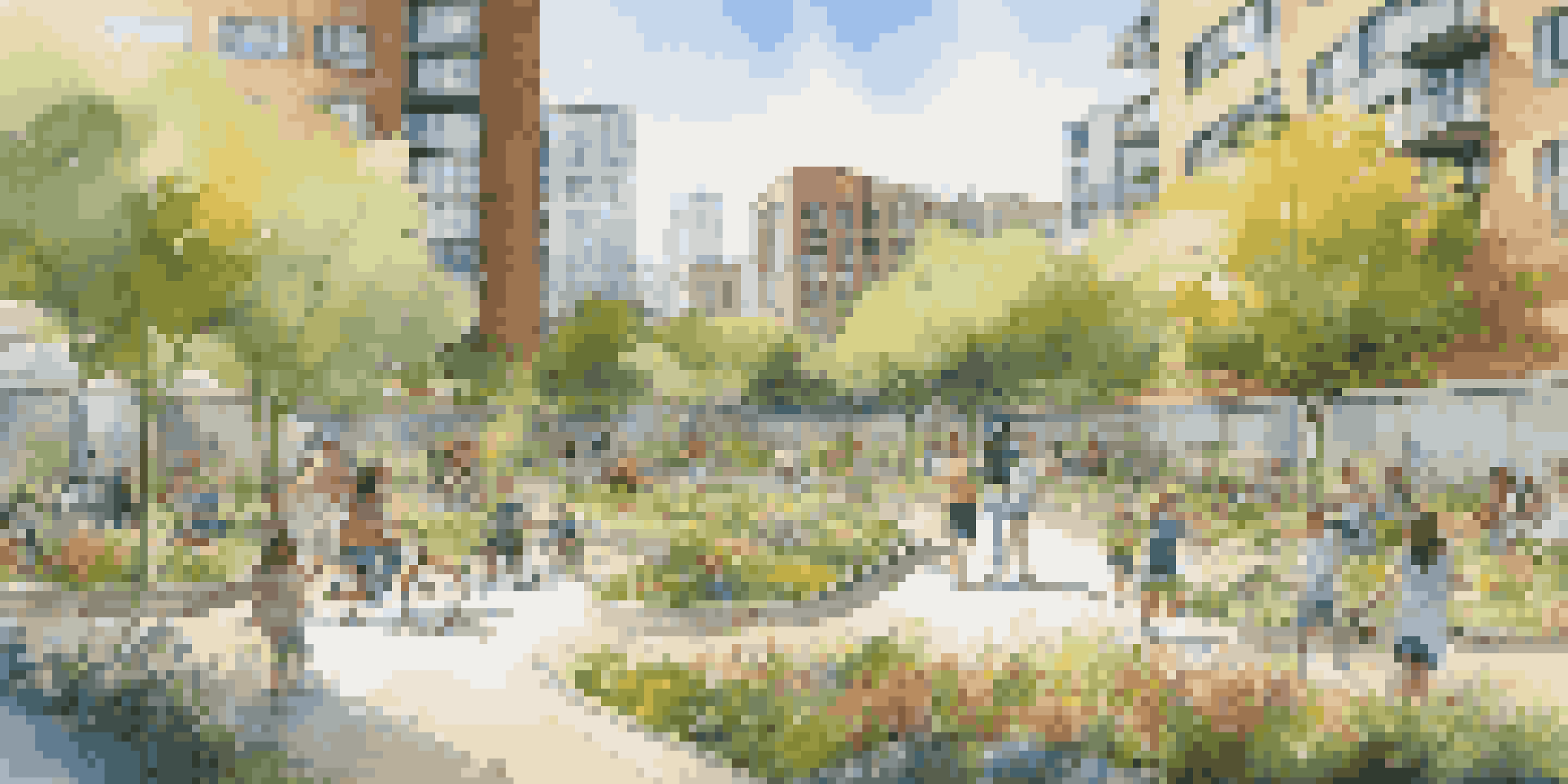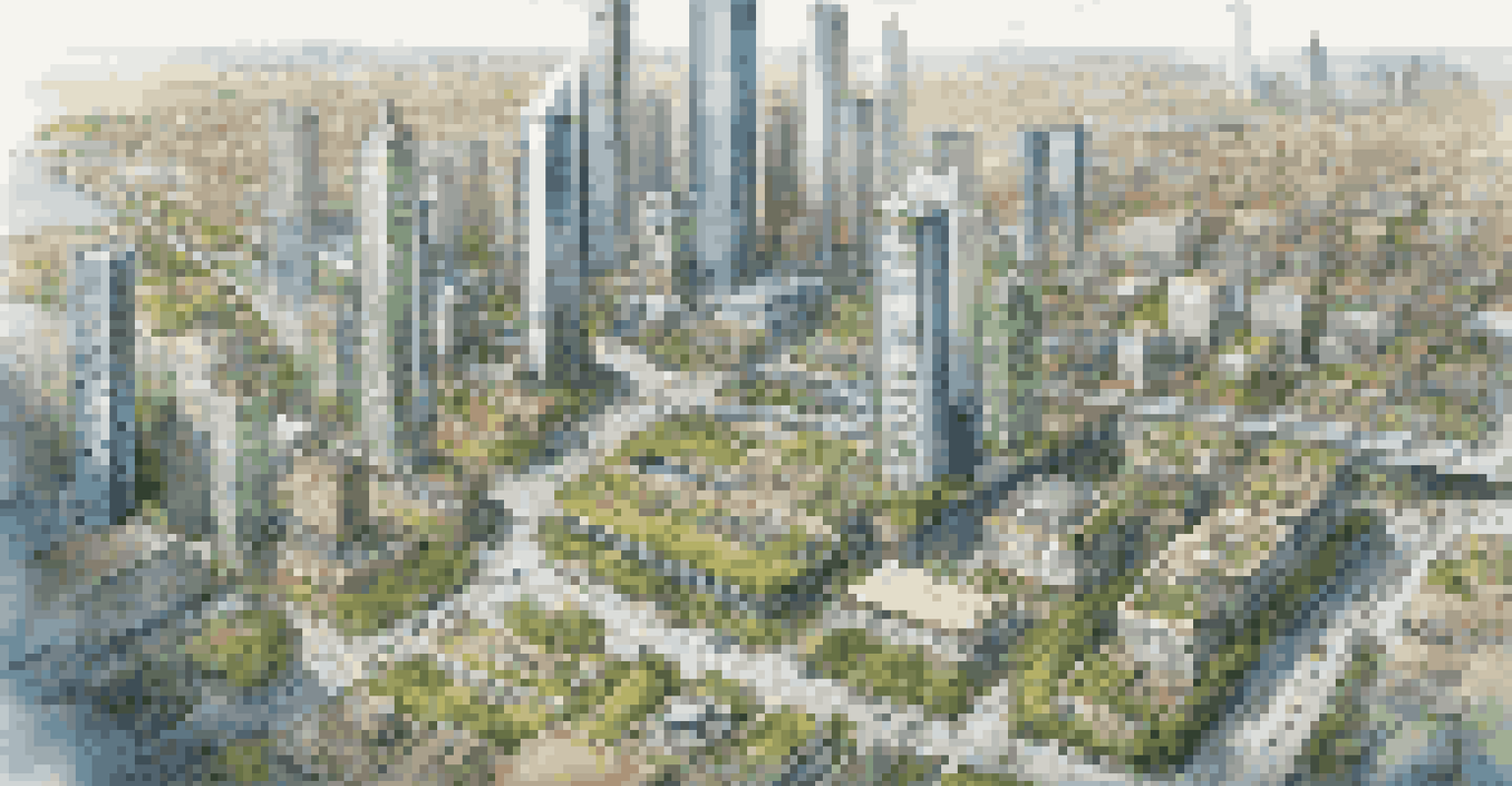The Future of Urban Living: Trends in Eco-Conscious Designs

The Rise of Sustainable Architecture in Urban Areas
Sustainable architecture is becoming increasingly popular as cities grow and environmental concerns rise. This design approach focuses on minimizing the ecological footprint of buildings, using materials that are not only efficient but also sustainable. For example, many new urban developments are incorporating recycled materials and renewable energy sources, significantly reducing their impact on the environment.
Sustainability is no longer about doing less harm. It's about doing more good.
The idea is to create spaces that harmonize with nature rather than disrupt it. This means integrating features like green roofs, which not only provide insulation but also support biodiversity by creating habitats for wildlife. By prioritizing sustainability in architecture, cities can foster healthier environments for their residents while also combating climate change.
As we look to the future, the challenge will be to balance urbanization with sustainability, ensuring that new buildings contribute positively to the ecosystem. By embracing innovative architectural designs, cities can set a precedent for a more sustainable way of living.
Green Spaces: The Heart of Eco-Conscious Urban Living
Green spaces are essential for promoting well-being in urban environments. Parks, community gardens, and green corridors not only beautify cities but also improve air quality and provide spaces for recreation and relaxation. Imagine stepping outside your apartment to a lush park where you can unwind or engage with nature—this is the vision many urban planners are striving to create.

The integration of nature into urban design has been shown to enhance mental health and foster community connections. For instance, neighborhoods that prioritize green spaces often experience lower crime rates and higher levels of social interaction among residents. This shift towards more greenery illustrates a growing recognition of the importance of nature in our daily lives.
Sustainable Architecture is Key
Sustainable architecture minimizes ecological footprints through eco-friendly materials and innovative designs.
Looking ahead, cities are likely to invest more in developing and maintaining these green areas, ensuring they remain accessible to all. By making green spaces a priority, urban living can become more enjoyable and sustainable.
Smart Technology: Enhancing Eco-Conscious Living
Smart technology is revolutionizing urban living, making it easier for residents to live eco-consciously. Devices like smart thermostats and energy-efficient appliances help reduce energy consumption, while apps can optimize waste management and encourage recycling. This integration of technology not only enhances convenience but also promotes sustainable habits among urban dwellers.
The greatest threat to our planet is the belief that someone else will save it.
For example, smart city initiatives are using data to manage resources more efficiently, reducing waste and energy use on a larger scale. These innovations enable cities to monitor everything from traffic patterns to energy consumption in real-time, allowing for quicker responses to environmental challenges. It’s like having a personal assistant for the planet, helping us make better choices.
As technology continues to advance, the potential for creating more sustainable urban environments will only grow. Embracing smart technologies will be key to fostering eco-conscious living in the future.
Community-Centric Designs: Building a Sense of Belonging
Community-centric designs focus on creating environments that foster connections among residents. This approach emphasizes shared spaces, such as communal gardens and gathering areas, which encourage interaction and collaboration. Think of it as designing neighborhoods that feel more like extended families than isolated units.
These designs can cultivate a sense of belonging, which is essential for mental well-being. When people feel connected to their community, they are more likely to participate in local initiatives, from sustainability programs to neighborhood watch groups. The result is a vibrant, engaged community that works together toward common goals.
Green Spaces Enhance Urban Living
Integrating parks and gardens into urban design promotes well-being and fosters community connections.
As urban living evolves, prioritizing community-centric designs will be vital. By nurturing these connections, cities can create supportive environments that enhance the quality of life for all residents.
Modular and Adaptive Housing: Flexibility for Urban Residents
Modular and adaptive housing is an innovative approach to urban living that offers flexibility and sustainability. These designs allow for buildings to be easily reconfigured or expanded based on the changing needs of residents. Imagine a home that can grow with your family or adapt to new purposes as neighborhoods evolve—this is the beauty of modular architecture.
This flexibility not only reduces waste by maximizing the use of existing materials but also addresses the growing demand for affordable housing. By creating adaptable spaces, cities can better accommodate diverse populations and lifestyles. This approach is particularly beneficial in urban areas where land is limited and housing costs are high.
Looking to the future, modular and adaptive housing could play a crucial role in shaping urban landscapes. By prioritizing flexibility, cities can ensure that their housing solutions remain relevant and effective for generations to come.
Water Management Innovations in Urban Design
Effective water management is critical in urban living, especially in the face of climate change. Innovative designs are emerging that utilize rainwater harvesting systems, permeable pavements, and green roofs to manage stormwater and reduce flooding. These approaches not only protect communities but also conserve valuable water resources.
For instance, cities are increasingly adopting bioswales—landscape elements designed to concentrate or remove debris and pollution from surface runoff. This not only helps manage water but also enhances the aesthetic appeal of neighborhoods. Imagine streets lined with beautiful, functional landscapes that also serve an important environmental purpose.
Policies Drive Eco-Conscious Practices
Effective policies can incentivize sustainable living and make eco-friendly options accessible to all residents.
As urban areas continue to grow, adopting advanced water management techniques will be essential. By integrating these innovations into city planning, we can create resilient urban environments that thrive in harmony with nature.
The Role of Policy in Promoting Eco-Conscious Urban Living
Policies play a vital role in shaping the future of eco-conscious urban living. Governments can incentivize sustainable practices through tax breaks, grants, and zoning regulations that favor green building initiatives. For example, cities that prioritize eco-friendly developments can attract like-minded businesses and residents, creating a thriving, sustainable community.
Moreover, effective policies can ensure that sustainability is not just an option for the affluent but accessible to everyone. By supporting affordable green housing and public transportation options, cities can promote inclusivity while fostering environmental stewardship. This holistic approach is critical for building resilient urban environments.

As we move forward, collaboration between policymakers, architects, and residents will be essential in creating effective regulations. By working together, we can ensure that urban living evolves in ways that are both sustainable and equitable.